I received a complaint from someone whos name may start with "P" and end with "lantnoobdude" that my last update didnt include a FTS

So ill start off with one just to get that bit sorted 😁
The four weird random sponges have been there since I got back home from after the fire.
I had some of the filter media floating in the tank in the handful of hours that passed between me getting back into the apartment and the electricians getting the power back on.
I put the ceramic filter media that belonged to the Eheim canister back that day, but havent had the energy yet to put back these sponges which belong in the Aquael canister.
I gotta get them put away so they stop shading the plants they are on top of. They're a part of the "emergency filter media" bits that I keep in that canister. When the kitchen tank is not running, the filter media that belongs to the HOB filter for the kitchen tank also lives inside the Aquael canister. This way the media remains biologically active for the periods of time I only run the main tank, and they are ready to be put in action if I need to set up a second tank on short notice.
Anyway, the tank has received a little bit of trimming to select plants but otherwise is still growing a bit wild, I like it a lot and the fish seem very comfortable in the increasing jungle of plants 😊
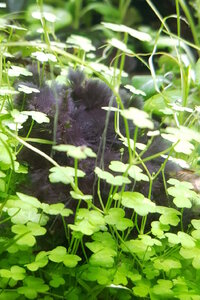
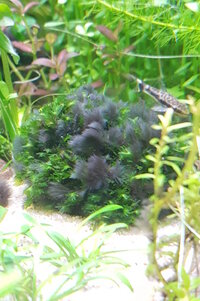
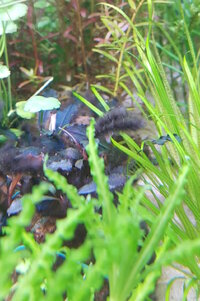
I have noticed a small to medium increase in BBA growth in my tank again, which is interesting to me

As a part of troubleshooting what might improve the coloration of the frogbit lately, I have been frontloading more micros for the past few water changes.
Instead of frontloading half the weekly amounts (0.21 Fe as proxy), I frontloaded the water change water with the full 0.42 ppm dose.
This didnt noticeably improve the plant symptoms I was looking for, but lines up roughly with the increase in BBA.
This may be peak heresy to some, but
since this forum has several extremely long and inconclusive threads about how BBA works, perhaps it could be useful to reconsider a few factors that have previously been more or less dismissed.
Very annoyingly, some of the trends that I have seen with BBA growth in my tank are not clearly indicative of whether organic pollution, fluctuating CO2 levels, or excess or imbalanced micros were a part of the cause.
I currently consider it likely that BBA growth is encouraged by a combination of factors, and that just because it happened because of "X" and "Y" for one person, does not mean it didnt happen because of "Z" for another person.
It seems likely to me that some will get BBA problems because of X and Y, some because of X and Z, some because of just Y, and so on.
Because we dont have a clear cut answer for what makes BBA thrive after much discussing, there appears to me to be a likelihood for variations in factors/causes.
That would help explain why its hard to nail down a specific cause that everyone can agree on.
For the algae, I think it only matters if enough factors in total are present in sufficient amount, then it will grow because the conditions create an available niche for it.
Ive also been pondering if the factors are more intertwined than we typically give them credit for. When we say organic pollution "or" fluctuating CO2 levels, we might be downplaying the connection between them.
For example like fluctuating CO2 levels causing organic pollution to increase. If the plants dont grow optimally, they might release more compounds into the water. Decaying plant growth contributes to organic pollution (this is not usually disputed).
But in reverse also, a polluted or poorly maintained tank could cause fluctuations in CO2 levels. Clogging of pipes and intakes causes changes in the level of flow. Changes to the surface of the water, like oil films or dense thickets of plants causes offgassing to be altered, resulting in changes to CO2 levels. They seem quite interlinked to me.
Now for some more heresy though

Some people who struggle with BBA have tried improving, tweaking, checking and doublechecking the two factors mentioned above with limited success in curbing the amount of BBA in their tank.
If excess micro dosing and/or imbalanced micro dosing causes the plants not to grow optimally... The plants may release more organics, and they might not be able to properly utilize the amount of CO2 that is available in the tank.
If on top of that there is excessive excess of nutrients that BBA likes present in the water column, does it not make sense that BBA would show up?
In such a circumstance, correcting the micro dosing would then mean the plants grow better, pollute less, uptake more CO2, and there might be less excess in the water column.
When I have previously written about the period of time I had a really wicked amount of BBA growth, I had already identified that it could appear to be linked to organic pollution and fluctuating CO2 levels.
But this was also the same period of time that I was struggling a lot with the chlorosis issue in the plants. Because I was trying to rule out issues with iron uptake, there was a LOT of excess iron in the water column.
I had quite strongly pink water from EDDHA and fairly high readings on the test kits. So its possible that all three were present, and I wonder if they all contributed.
As usual, things are never quite as clear cut as I wish they were, and of course my tank has seen some instability lately with the house fire and everything associated with that. So I cant rule out other influences either.
But ill continue to observe my tank and write about my current thoughts, perhaps they will one day be helpful to someone

A little side note: I have a really fun looking staghorn kind of algae species in my tank.
One of the main reasons its "fun and interesting" is because it only shows up in the very occasional tuft here and there, its a rare ocurrence for me to find.
Usually I find it attached to an old rotting part of a plant or a really soft part of the driftwood.
What tickles my fancy about it is how "macro" it is. Its really cartoonishly large and thick, and very distinctly branched.
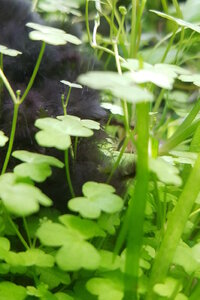
This is a really crappy picture of the tuft I found today.
Its super slimy too, so trying to grab hold of it is a real challenge, because it slips out of your grip very easily.
I have another tuft sitting in a cup in the kitchen that I wanted to put under the microscope to have a closer look at, but I ran out of energy that day and havent gotten around to it yet.
Frogbit update:
Still more pale than it should be. Still doing gradual fading out of older leaves before they are due.
The fading seems to start with some paling/chlorosis from the sides of the leaf that moves inwards towards the center line of the leaf.
The leaves are still thinner than they should be, and lately some mild deformity has appeared as well (third picture). Very interesting

Tank is still running on the same micro mix, but the time to make a new batch is coming up.
The tank got more water changes than usual for a period of time because of the recent events, and I expect that this has influenced how the nutrient dosing has been for the tank.
Now that things are stable again I have resumed my biweekly water changes, and accumulation will have had a bigger effect on what is plentiful and what might be in shorter supply in the water column.
I suspect that this is why the leaves have varied a little bit.
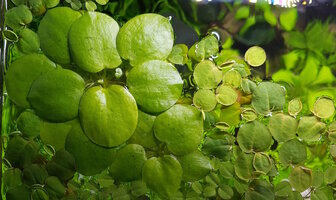
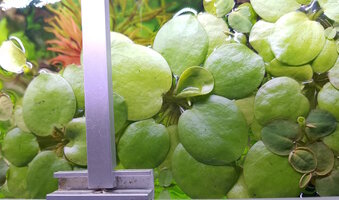
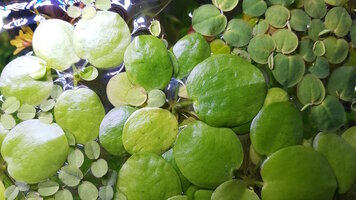
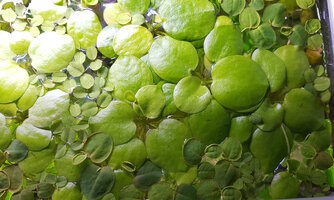
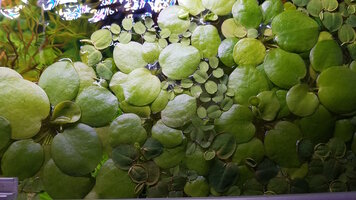
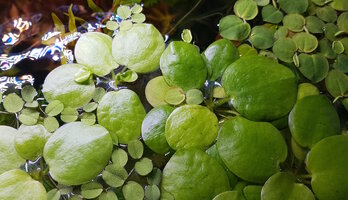
Some of the submerged plants are corroborating the input that im getting from the frogbit about (presumably) micros.
Even though things improved after increasing boron and zinc last time, im still seeing a little bit of deformity here and there.
There is a large variability from species to species in how strongly "symptoms" appear (and if they even appear at all).
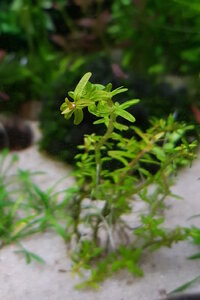
Some species(&varieties) like Rotala rotundifolia "Orange Juice" have been complaining about something for a long time now.
I attribute the longstanding issue with OJ to two things; Rotala rotundifolia likes to grow fast, and when it cant grow fast it likes to throw a tantrum.
Just like its other relatives from the infamous Lythraceae family. This also makes it a good indicator plant.
Rotala rotundifolia "Blood Red SG" has also complained, but not as much as OJ. There seems to be variation in severity even from variety to variety.
Im guessing that even the plant varieties could have slightly different parameter ranges that they are able to deal with without displaying anything obvious.
It seemed to me at first that these symptoms looked a lot like CO2 issues, so I had to spend a fair bit of time ruling that out first since its a really big one when youre troubleshooting.
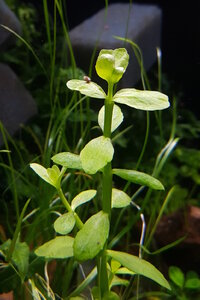
Bacopa madagascariensis has also put out some leaves that arent quite well formed.
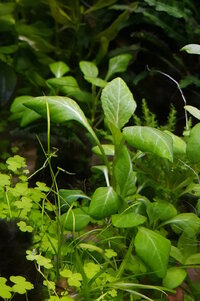
Lobelia cardinalis "Mini"
(which right now is not looking very mini )
) is doing some interesting downward cupping/curling.
But you know this micro stuff is still a relatively minor issue when...
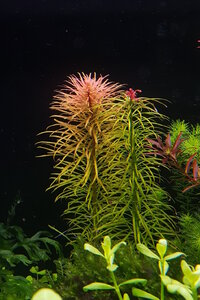 The drama queen is alive 😂
The drama queen is alive 😂
The Pantanal stem in the back got shortened and replanted, and is not showing any indications of badly stunting. Well I'll be damned! 🤯
I had my popcorn ready and everything to see how much it was gonna sulk this time. But no sulking 🤔
Even the stem thats in front of it that stunted when the tank was dark and without power, is putting out a new shoot instead of just dying outright. Thats also an improvement.
It seems conditions are more to Pantanals liking in my tank now than how it was about a year ago.
Many variables have changed since then, so I wouldnt be able to guess what.
It might even be a combination of many smaller things.
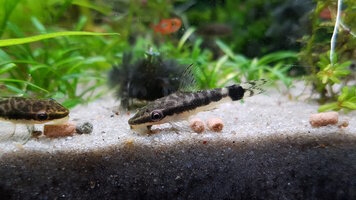
On the fishy side of things, ive had a few losses from the otos. I feel like im finally getting some sort of feel for this whole fishy health business, because not too long ago I would be freaking out at the first dead oto and putting heaven and earth in motion to try to figure out what caused it. Ive lost three otos now, and im fairly sure it had absolutely nothing to do with me.
All the other fish in the tank are in absolutely stellar health. These otos arent from the best store, and when I bought them I got a few that were a little fat looking.
I thought I was getting perhaps a few females that were carrying eggs, and you know they say "a fat oto is a happy oto". But I should have known they were just a little bit too fat.
The fattest one died first, from something resembling dropsy (organ failure and gaining water in the body as the kidneys stop functioning).
Dropsy tends to look very different in corydoras and otocinclus than in "normal fish", because the former two have armor plates instead of scales.
I could see this death coming once that fish increased beyond a certain size.
Some days after that the second fattest one turned in its oars, and then a third one a bit later.
As far as I can tell this damage had already been done when the fish were in the store, and I dont think there was much I could have done to change it.
I havent seen any dead fish after that, so it appears that the ones that werent gonna make it have passed now.
I havent had the opportunity to count the otos in the tank right now, but I should try to do that soon to see if I can still account for all the rest of them.
The rest of them appear pretty healthy and I havent seen any more suspiciously fat ones.
Knowing when to intervene and when not to intervene is a part of the hobby that I think is really difficult.
I sure have taken a long time to get where I feel like I have even vaguely an idea of what to do.
I seem to have made the right call with the otos, and im glad about that.
Im still really enjoying the tank and might be back with more ramblings soon 😊

















 )
)


